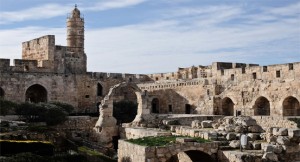Archaeologists found possible site of Jesus trial in Jerusalem
Archaeologists say they have exposed the remains of King Herod’s palace in Jerusalem and with it the site where the trial of Jesus may have taken place.
The location, near the city’s historic Tower of David, differs from other suggestions for the site of one of history’s most renowned court events, most notably the Antonia Fortress along the pilgrimage route known as the Via Dolorosa, or Way of Sorrows.
The Kishle, an old prison build by the Ottoman Empire nearby to the Tower of David, sat atop ruins of an earlier palace built by Rome’s king of ancient Palestine, Herod, said Amit Re’em, Jerusalem District Archaeologist for the Israel Antiquities Authority, according to the Jerusalem Post.
For two years we excavated this by hand. We dismantled the prison cells but sealed the English, Arabic and Hebrew graffiti that the prisoners had carved,” Re’em told the newspaper.
A police compound neighboring to the Kishle reminds one of the connection of this site; it has been manned by soldiers since the time of the Hasmoneans and before, a considered highpoint chosen by Herod and other kings as a place for a palace and citadel,” the newspaper account said.
Re’em said proof of pools and water conduits — items favored by Herod and noted by historians such as Flavius Josephus — suggest Herod’s palace was here, and that Pilate, who would have been a tourist in Jerusalem at the time of Jesus’ arrest, would have used a space in Herod’s palace for the trial.
We have the retaining walls,” Re’em told the Christian Broadcasting Network last April. “It was an enormous engineering project, and we see it in the excavation. We even found a vast underground sewage that could only belong to the palace of Herod.”
For those Christians who care about truth in regards to historical facts, this is very forceful,” Yisca Harani an expert on Christianity and pilgrimage to the Holy Land told The Washington Post. “For others, however, those who come for the universal mental exercise of being in Jerusalem, they don’t care as long as ends in ‘Golgotha’ — the site of the crucifixion.”
Where trial leading to the crucifixion took place depended on the times in which pilgrim routes were determined, Washington Post reporter Ruth Eglash noted.
In the Byzantine period, for example, the Via Dolorosa began closer to the area where the museum now sits in the western part of the city. It was only after the 13th century that the starting point moved to the Antonia Fortress, the site of a ex- Roman military barracks, which today sits beneath a school close to the al-Aqsa mosque and the golden Dome of the Rock,” Eglash wrote.
Shimon Gibson, an archaeology professor at the University of North Carolina at Charlotte, told Eglash he believes the Kishle may well be the site where Jesus was tried, given the Gospel of John’s report of the trial taking place near a gate on ground with paving stones.
There is, of course, no inscription stating it happened here, but everything — archaeological, historical and gospel accounts — all falls into place and makes sense,” Gibson told the newspaper.
Every year, an expected 1 million Christian pilgrims visit Jerusalem.
